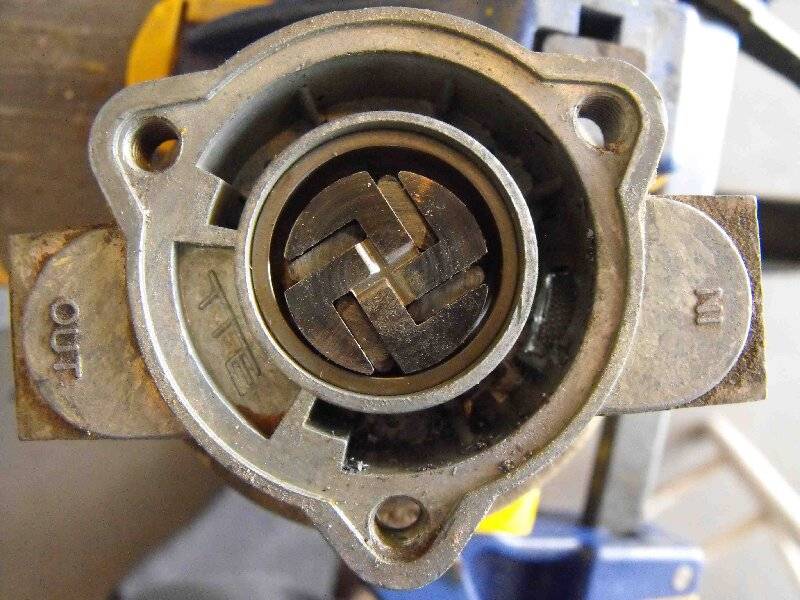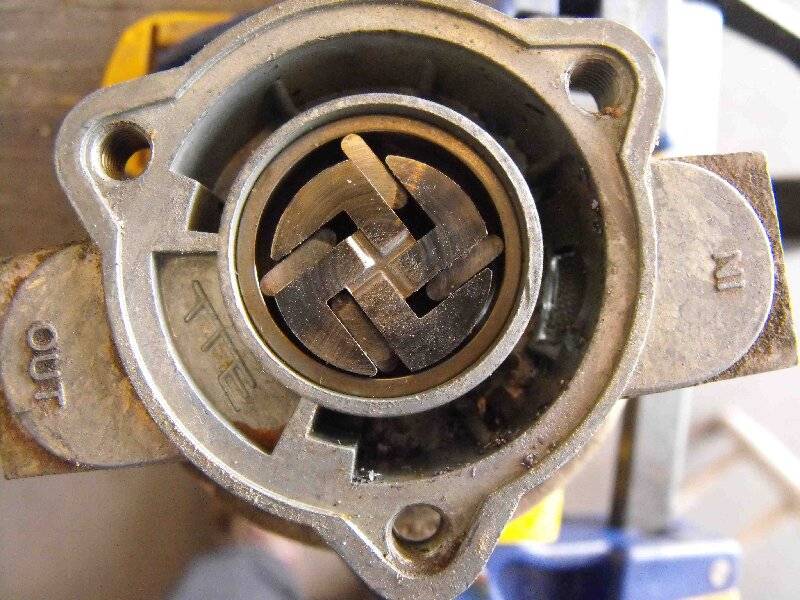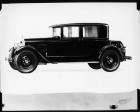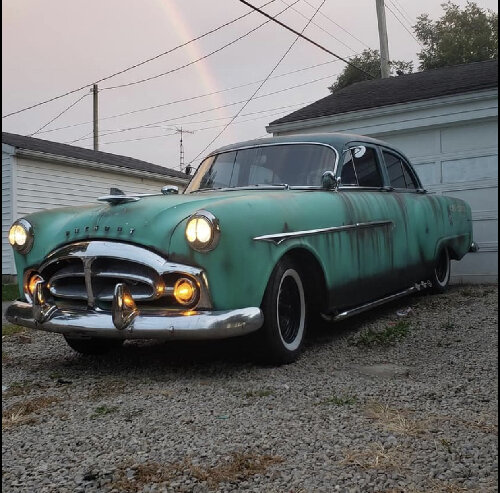|
Re: Motor suddenly dying
|
||||
|---|---|---|---|---|
|
Home away from home
|
Packard51; my ’48 had the same symptom of running for many miles without incident, and then after a sharp turn the carburetor ran out of gas . . . but I’m getting ahead of the story. I know now it was running out of gas, but at the time all I knew was the engine would stop running. The car was equipped with an electrical fuel pump intended for ‘priming’. The instructions I was provided indicated that the e-pump was not necessary after priming. Ultimately there was sufficient evidence to conclude that the instructions were incorrect in that the pump should have been powered continuously.
To paraphrase Paul Harvey, “And now, the rest of the story”: There are two types of e-pumps currently available in a 6 volt configuration. One design operates somewhat like a solenoid with a set of points to cut the power feed when the core nears the end of the stroke. The whole mess operates as a spring/mass system cycling as long as external power is available. These pumps are available from Airtex, and allow the engine’s mechanical fuel pump draw through them with no apparent difficulty. The second design is a rotary vane pump, without springs to bias the position of the vanes, which becomes important detail on whether the engine’s mechanical can draw through the e-pump. If the e-pump is installed per the manufacturer’s instructions most of the time when the power is cut the vanes relax enough to allow the engine pump to ‘draw through’ the e-pump until something disrupts the position of the critical vane . . . like a sharp turn. If the vane disruption blocks the fuel flow that’s ‘game-over’ the engine will run out of fuel. If however the disruption increases the most critical flow area the ‘game-continues’ with the driver completely unaware that anything has occurred. Some have used a rotary vane pump in conjunction with a bypass loop with a check valve, all of which allows the e-pump to be de-powered after priming. My ’48 had a rotary vane pump, no by-pass loop, and the description I got from the previous owner was to use the pump as if it was a solenoid type pump. That car got so predicable on which turn it would ‘quit’ I would turn the e-pump on to avoid the possibility of stalling. I temporarily installed an electric fuel pressure gauge, and amazed myself when the fuel pressure when to zero on one of the notorious turns. I tore-down the vane pump and confirmed the blockage hypothesis. During one experiment the pump was reassembled with the critical vane positioned well out of the way. In that configuration it was quite easy to blow air through the pump, but when the pump was positioned so gravity pulled the vane into the minimum area position the flow became quite restrictive. There is a very long list of what could make an engine stop running, but your comment about the previous owner installing an e-pump brought back memories. Please identify the e-pump design and plumbing details. dp
Posted on: 2023/4/28 23:11
|
|||
|
||||
|
Re: Motor suddenly dying
|
||||
|---|---|---|---|---|
|
Home away from home
|
I knew of that problem with the rotary pumps but had no idea why it was they sometimes worked. Thanks for the explanation.
Posted on: 2023/4/29 5:27
|
|||
|
||||
|
Re: Motor suddenly dying
|
||||
|---|---|---|---|---|
|
Home away from home
|
I've driven old cars all my life, with many having been dragged from junkyards and put back on the road. I've never found it necessary to put an electric fuel pump on any car.
A dirty fuel tank will cause on-going issues until it is fixed or replaced. The same is true of leaky fuel lines, or mis-routed fuel lines. Adding a filter, especially a paper type, on the suction side of any fuel system is a prolific source of problems. Cars that have a high-mounted fuel pump, like flathead Fords and some old Cadillacs and Lincolns, are prone to vapor lock in hot weather. These systems will perform well, if they are in good condition, with no need to add any kind of booster pump. Always check for an incorrect or malfunctioning gas cap, and be sure that the fuel tank vent, on cars so equipped, is not blocked with bug nests or debris.
Posted on: 2023/4/29 7:40
|
|||
|
||||
|
Re: Motor suddenly dying
|
||||
|---|---|---|---|---|
|
Home away from home
|
Ross, here’s something Paul Harvey couldn’t do . . . provide a picture or two.
The following are photos of a Carter rotary vane pump with the end cap removed. From this view pump rotation would be CCW, with the flow path starting at 03:00 and continuing to 09:00. The outer partial ring is the fluid inlet cavity, which held the screen protecting the pump from tank debris. Photo – PumpVanesIn shows all of the vanes fully retracted into the driven element. In this position the engine mechanical fuel pump would draw fuel through the Carter pump. Photo – PumpVanesOut shows the other extreme of vane position. This would be the positions as the pump is running. Note the cavity between the vanes at 12:00 and 03:00, which would rotate CCW to the outlet passage. If the vanes achieve this position when the pump is not running the engine mechanical fuel pump would not draw fuel. It is centrifugal force that forces the tip of the vane to follow the circular outer wall of the pump. When the pump is not running the vanes shown at essentially 12:00 and 03:00 are free to move. If they happen to move inward away from the outer wall then the engine mechanical pump will likely function properly. If the either vane is very near the outer wall the mechanical pump will lose capacity and will be more susceptible to ‘vapor lock’. There are no springs to bias the static position of the vanes. It’s a personal choice whether to install an e-pump for pre-start priming, but infrequent use of the car and storage in a hot climate are factors that influence the choice. I agree with TxGoat’s assessment that, when new, these cars didn’t need e-pumps, and his observation that a fine filter should never be placed on the inlet side of a pump is 100% correct. Typically coarse mesh screens are used on the inlet side. It sounded from Packard51’s first posting that his car mysteriously stopped running after a significant amount of time running well. He also mentioned an e-pump was installed in the car. If this is an intermittent condition the best plan is to investigate the fuel/spark/air basics, as BigKev stated. Packard51’s problem could easily be carburetor related, and be a gross flooding condition because the needle and seat fuel valve is stuck in the full open position, which if that’s the case, turning on the e-pump is the last thing you would want to do. I would approach the problem one system at a time . . . I’ve been tricked thinking a fuel problem was electrical ( and the other way around ) several times in my life, so Packard51 try to use a methodical approach. dp
Posted on: 2023/4/29 11:40
|
|||
|
||||
|
Re: Motor suddenly dying
|
||||
|---|---|---|---|---|
|
Just can't stay away
|
Thanks for the photos, I'm a very visual guy so that helps! I am making a checklist and will check one thing at a time! Again, many thanks to everyone!
Posted on: 2023/5/1 7:40
|
|||
|
||||
|
Re: Motor suddenly dying
|
||||
|---|---|---|---|---|
|
Just can't stay away
|
Well, last weekend my Daughter came over, she has been wanting to help, and we discovered that one of the plugs had popped-off, re-crimped both and put a small zip-tie to keep it snug. Hopefully, Saturday will will get her running again!
Posted on: 2023/6/22 10:41
|
|||
|
||||
|
Re: Motor suddenly dying
|
||||
|---|---|---|---|---|
|
Home away from home

|
humanpotatoehybrid.
Thats an issue with my 55 400. will only pull 14 gallons of gas before it is "empty". Could be rusted pin holes or a split in the pickup tube seam. For now...working with 150 mile range around town:{ until I can dive into the tank.
Posted on: 2023/6/23 9:36
|
|||
|
Where principles are involved, be deaf to expediency. (Matthew Fontaine Maury 18th century oceanographer)
|
||||
|
||||

 PumpVanesIn.JPG (236.07 KB)
PumpVanesIn.JPG (236.07 KB)








